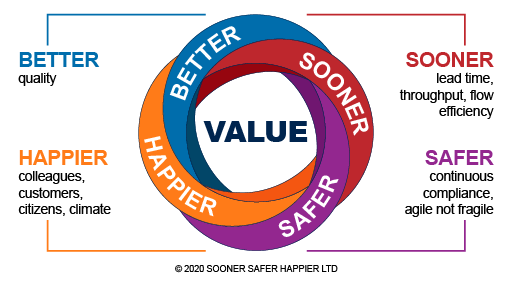5.6 Better Value Sooner Safer Happier
Choosing the right approach for the problem you need to address is important, especially if you are focusing on problems that are connected to digital transformation. Approaches that have evolved based on the use of technology can guide you and help you discover insights that are specific to dealing with decisions and/or problems that involve digital transformation.
The Better Value Sooner Safer Happier (BVSSH) approach, developed by Jonathan Smart and colleagues (2022), helps you define your problem and provides a powerful roadmap to delivering your objectives and measuring the success of your outcomes. Like many others, the creation of the approach started with ‘why?’ (such as: Why do we need a better way of working and a better way of creating value?) which evolved out of their work with information technology firms.
Sooner Safer Happier is a textbook based on decades of practical experience of improving ways of working in hundreds of organisations. Learnings are structured into eight ‘patterns’ and ‘antipatterns’ for business agility.
A pattern is a response to a situation that, more often than not, is effective and improves desired outcomes. Of course, this all comes with ups and downs, back and forth, it’s all about the people. A pattern can help to create a tailwind for change.
The antipattern is to deploy a capital ‘A’, capital ‘T’, Agile Transformation across your organisation, with fixed scope/budget/plan, i.e. to apply old ways of thinking to new ways of working, which is unlikely to generate the desired benefits.
Table 10 explains the kind of organisational problems these patterns can assist with.
| Organisational problem | Desired outcome |
|---|---|
| ‘We’re too expensive and inefficient. It’s too hard to get anything done, and organizational inertia is holding us back. The cost of change is high and it takes ages. We have to be more efficient!’ | I want more efficient delivery of value |
| ‘We need to get better at benefits management. We don’t really know what value our change investments are adding, it’s just opinion. We have to get smarter at articulating, measuring, and prioritizing highest value!’ | I want to optimize for highest value |
| ‘Things take too long. If we don’t change we will not exist. We are not keeping up with the competition. Doing nothing means we are going backward quickly. We have to accelerate.’ | I want to decrease time to value |
| ‘When our delivery teams hit the risk and control gates it doesn’t matter whether they are agile or not, they all slow to the same speed. It can feel like we have governance gridlock, yet we are highly regulated and must manage risk and maintain regulatory trust.’ | I want to have both speed and control |
| ‘Our best people keep leaving. The talent market is so competitive. Our staff turnover is really wasteful. We lose knowledge and reputation. We have to get better at attracting and retaining the best talent.’ | I want a more engaged workforce |
| ‘We waste a lot of time talking about it. We have some pockets of improvement, but there is no shared understanding. Everyone has such entrenched beliefs. The arguments can get heated. Our energy needs to be focused on making real improvement.’ | I want to know why ways of working matter |
| ‘We have talked about transformation for a long time and made a start. We’re making some progress in IT but the wider organization is not yet feeling the benefit. As a leadership team we want to improve outcomes and we want lasting change.’ | I want to nurture cultural change |
| ‘For our organization to survive and thrive we know we have to adapt quickly. The scale of change is daunting and we are not sure where to begin making these changes.’ | I want to know where to (re)start |
| ‘Our investment funding is tied to detailed upfront business cases and annual project cycles. It’s hard to understand what a different funding model might look like in new ways of working.’ | I want to know how to fund agility |
In the video below Myles Ogilvie and Matt Turner (both Principals at Sooner Safer Happier Limited) explain the principles of Better Value Sooner Safer Happier.

Transcript: Video 20 Better Value Sooner Safer Happier introduction
Activity 20 Learn more about Better Value Sooner Safer Happier
Read the article ‘What is BVSSH?’ [Tip: hold Ctrl and click a link to open it in a new tab. (Hide tip)] (Smart, 2022) and then explore the Sooner Safer Happier website to discover more about this approach.
Consider how focusing on outcomes might help with developing more robust ways of working. You may wish to make notes in the box below.
If this is an approach that is of interest to you the Better Values Sooner Safer Happier team have created a course for OpenLearn to develop your understanding further which you may wish to study as well. Introduction to business agility - OpenLearn - Open University

